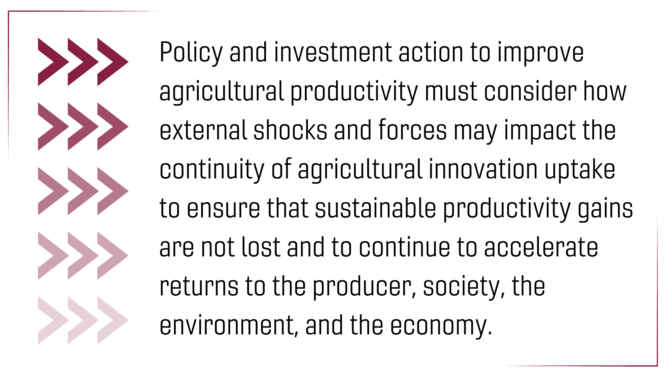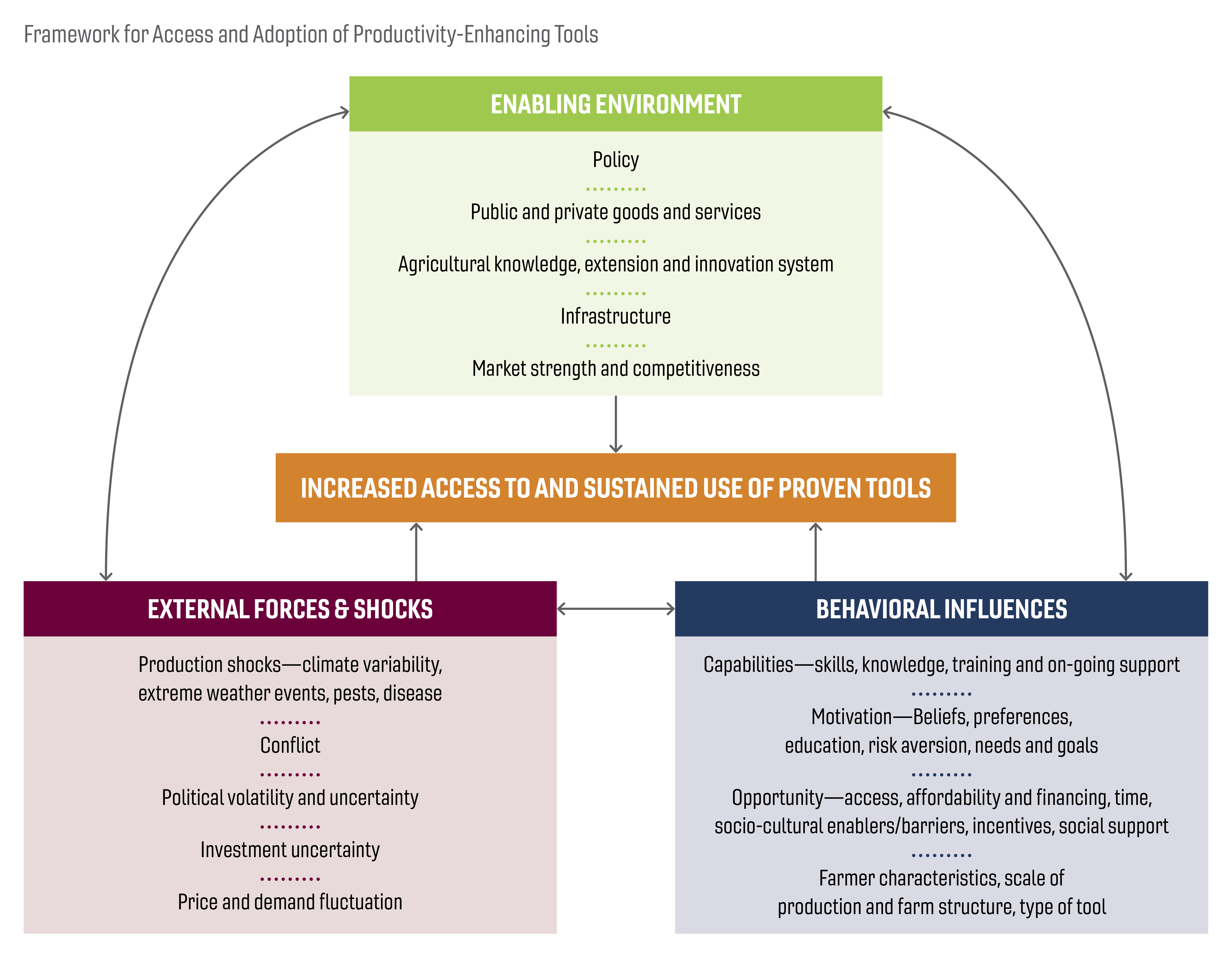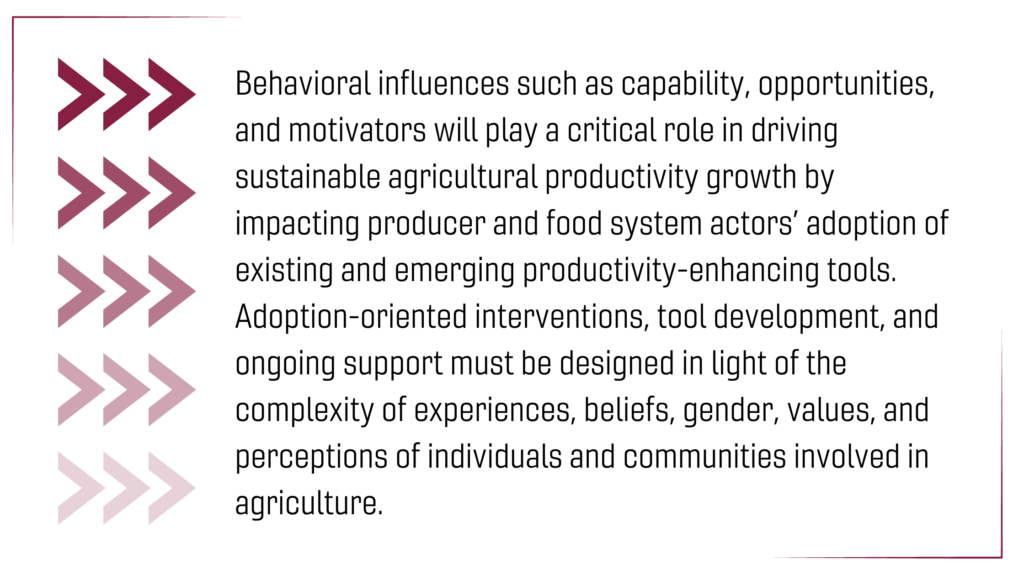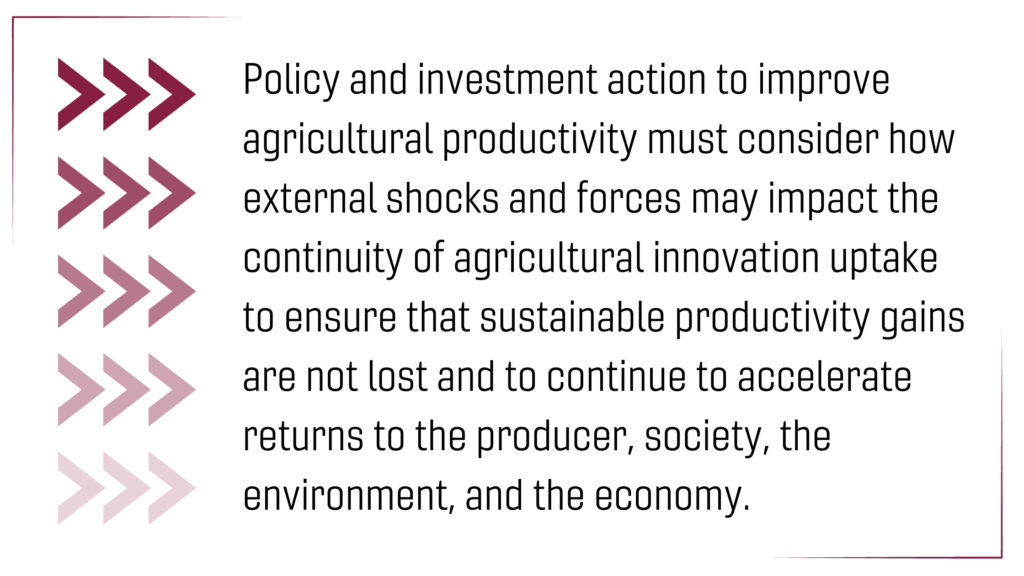Since the 1970s, agricultural innovation of technologies, practices, and strategies have contributed to more productive agricultural systems that are increasingly able to provide returns to producers, society, the environment, and the economy. However, the previous decade’s (2011–2021) sluggish TFP growth suggests that, particularly in low-income countries, the adoption rate of proven productivity-enhancing tools is not sufficient to contribute to sustainable productivity growth.
To reach the new annual target TFP growth rate of 1.91 percent and to reduce the need to increase agricultural output through unsustainable practices, we must seek to lessen the barriers that farmers at all scales of production face in accessing and adopting proven, appropriate productivity-enhancing tools.
PROVEN & EMERGING TOOLS FOR SUSTAINABLE TFP GROWTH
There are well-established tools—including technologies, practices, and strategies—that have demonstrated success in improving farm efficiency and sustainable productivity by optimizing resource utilization and minimizing environmental and economic costs. Ongoing R&D improves existing tools and identifies and validates new ones to sustainably improve productivity, farmer livelihoods, environmental and human health, and economic growth.
INCREASING ACCESS AND ADOPTION OF PRODUCTIVITY-ENHANCING TOOLS
Producer access to and sustained adoption of productivity-enhancing tools is impacted by the wider enabling environment, behavioral influences, and external forces and shocks (Figure 9). Within each of these milieus, barriers and opportunities for tool uptake are reinforced by socio-economic contexts, production scale, and the agro-ecological environment. This framework can be used to identify policies and investments that will ensure every farmer has access to and can sustainably adopt every proven, appropriate productivity-enhancing tool.
ENABLING ENVIRONMENT
Agricultural productivity growth is impacted by the multifaceted setting of the agricultural sector, food systems, and the wider economy. This enabling environment for tool access and adoption includes (1) policy (agricultural, macroeconomic, non-farm sectors), (2) public and private provision of goods and services, (3) the agricultural knowledge, extension, and innovation system, (4) infrastructure, and (5) market strength and competitiveness.
The enabling environment affects access to and adoption of sustainable productivity-enhancing tools by influencing the resources available for research and development the flow and dissemination of tools, incentives for technological adoption, magnitude and variability of returns on investment, uncertainty and risk, and long-term availability. Examples from across the world demonstrate how these elements work alone and in concert to foster enabling conditions or barriers to accessing and sustaining the adoption of proven, appropriate productivity-enhancing tools (Table 1). The enabling environment is largely dependent on political will, perceived economic growth opportunity, and available evidence to inform the efficacy of policy and practice, illustrated in the examples in Table 1.
As illustrated in Figure 9, the enabling environment is influenced by external forces and shocks and behavioral influences and vice versa. For example, extreme weather events or conflict and civil unrest can influence policy priorities, available resources, macroeconomic conditions, and physical infrastructure. Conversely, deregulations in the financial sector and increasing demand for agricultural products, including biofuels, exchange rate fluctuations, and global economic growth, contributed to the 2007–2008 food price crisis that created widespread shocks to food systems and food security around the world (Hochman et al., 2014; Brobakk & Almas, 2011).
Research shows that in low-, middle-, and high-income countries alike, producer and food system actor decision-making and behavior related to technological and innovation adoption are highly influenced by the enabling environment. Policies, access to agricultural knowledge, training, goods and services, infrastructure, and market incentives all influence behavior change, particularly by affecting the risk (perceived or actual) of tool adoption. Producer risk aversion and lobbying in the agricultural sector may in turn impact the enabling environment.

BEHAVIORAL INFLUENCES
Even if productivity-enhancing tools are made more accessible by a robust enabling environment, adopting these tools on a sustained basis may require considerable behavior change by producers and other food system actors.
Especially in low-income countries, technology and innovation adoption can be associated with modernization and development, which may be at odds with socio-cultural value systems and indigenous production knowledge and priorities (Curry et al., 2021). Action and investment strategies should be tailored to affect factors of behavior change, such as the capabilities, opportunities, and motivators for producers and food system actors to adopt and sustain the appropriate use of productivity-enhancing tools.
The impact of interventions targeting productivity-enhancing technology and innovation are mediated by COM-B elements as well as characteristics of the producer or other food system actors, the scale of production, and the type of tool. Table 2 gives examples of how behavioral factors affect sustained adoption of various productivity-enhancing tools.

Capability, opportunity, and motivation are three factors that have demonstrated an impact on changing behaviors (COM-B) (Michie et al., 2011), including agricultural technology and innovation adoption.
Capability refers to the psychological (e.g., knowledge, skills) or physical factors (e.g., required equipment, physical strength) that would lead to a producer adopting a productivity-enhancing tool on a sustained basis.
Opportunities include physical places to acquire the technology, required inputs to apply the technology, affordability and financing, social support of the behavior change (including farmer organizations), and economic and environmental resources (e.g., savings, a water source for irrigation).
Motivation refers to the internal processes that influence decision-making and behavior change. This includes personal beliefs and perceptions (e.g., risk aversion, technology acceptance), outcome expectations, and self-efficacy (the belief that one has the power to change behavior).

EXTERNAL FORCES & SHOCKS
The uncertainty and risk that producers and other food system actors face in bringing food from farms to the table are well known. The impact of exogenous events on production, such as losing an entire crop to a new disease or pest, motivates the improvement of agricultural knowledge and innovation systems. External shocks and other types of forces also have a direct role in the accessibility and sustained adoption of productivity-enhancing tools. The past several years have demonstrated that climatic variability, extreme weather events, conflict, political uncertainty and volatility, changes in investment, and price and demand fluctuation can cause smallholder producers to fall back down the innovation curve, losing important gains in agricultural productivity.
Fertilizer use, for example, has dropped off significantly in sub-Saharan Africa as a result of the crisis in Ukraine and resulting increases in fertilizer prices (Pinto, 2022). Even in high-income countries such as Canada, the Netherlands, the U.S., Denmark, and the UK, where producers are less economically vulnerable, external forces such as political uncertainty (e.g. unanticipated regulations) act as a deterrent to investing in smart farming technologies (Eastwood & Renwick, 2020).

Behavior and decision-making are largely informed by the perceived threat of external shocks and forces. Especially within smallholder production systems that have significant potential for sustainable agricultural productivity growth, economic vulnerability increases the impact of external shocks (e.g., production, health) on technological adoption. This may discourage producers from ever investing in agricultural innovations, such as modern irrigation technology in China (Tan et al. 2021) or improved seeds in Ethiopia (Gebremariam & Tesfaye, 2018). It could also lead to producers returning to less productive practices and tools due to a lack of affordability or availability.
External shocks and forces also mediate access and adoption by affecting the enabling environment. For example, changes in political regimes transitioning to military rule not only destroy agricultural systems from violence and conflict but also create dysfunctional policy environments and negatively impact trade. Sudan and Niger, for example, are likely to see further declines in agricultural productivity, food insecurity, and household resilience as a result of political volatility coupled with extreme weather events (IFRC, 2023).
Since the 1970s, agricultural innovation of technologies, practices, and strategies have contributed to more productive agricultural systems that are increasingly able to provide returns to producers, society, the environment, and the economy. However, the previous decade’s (2011–2021) sluggish TFP growth suggests that, particularly in low-income countries, the adoption rate of proven productivity-enhancing tools is not sufficient to contribute to sustainable productivity growth.
To reach the new annual target TFP growth rate of 1.91 percent and to reduce the need to increase agricultural output through unsustainable practices, we must seek to lessen the barriers that farmers at all scales of production face in accessing and adopting proven, appropriate productivity-enhancing tools.
INCREASING ACCESS AND ADOPTION OF PRODUCTIVITY-ENHANCING TOOLS
Producer access to and sustained adoption of productivity-enhancing tools is impacted by the wider enabling environment, behavioral influences, and external forces and shocks (Figure 9). Within each of these milieus, barriers and opportunities for tool uptake are reinforced by socio-economic contexts, production scale, and the agro-ecological environment. This framework can be used to identify policies and investments that will ensure every farmer has access to and can sustainably adopt every proven, appropriate productivity-enhancing tool.
ENABLING ENVIRONMENT
Agricultural productivity growth is impacted by the multifaceted setting of the agricultural sector, food systems, and the wider economy. This enabling environment for tool access and adoption includes (1) policy (agricultural, macroeconomic, non-farm sectors), (2) public and private provision of goods and services, (3) the agricultural knowledge, extension, and innovation system, (4) infrastructure, and (5) market strength and competitiveness.
The enabling environment affects access to and adoption of sustainable productivity-enhancing tools by influencing the resources available for research and development the flow and dissemination of tools, incentives for technological adoption, magnitude and variability of returns on investment, uncertainty and risk, and long-term availability. Examples from across the world demonstrate how these elements work alone and in concert to foster enabling conditions or barriers to accessing and sustaining the adoption of proven, appropriate productivity-enhancing tools (Table 1). The enabling environment is largely dependent on political will, perceived economic growth opportunity, and available evidence to inform the efficacy of policy and practice, illustrated in the examples in Table 1.
As illustrated in Figure 9, the enabling environment is influenced by external forces and shocks and behavioral influences and vice versa. For example, extreme weather events or conflict and civil unrest can influence policy priorities, available resources, macroeconomic conditions, and physical infrastructure. Conversely, deregulations in the financial sector and increasing demand for agricultural products, including biofuels, exchange rate fluctuations, and global economic growth, contributed to the 2007–2008 food price crisis that created widespread shocks to food systems and food security around the world (Hochman et al., 2014; Brobakk & Almas, 2011).
Research shows that in low-, middle-, and high-income countries alike, producer and food system actor decision-making and behavior related to technological and innovation adoption are highly influenced by the enabling environment. Policies, access to agricultural knowledge, training, goods and services, infrastructure, and market incentives all influence behavior change, particularly by affecting the risk (perceived or actual) of tool adoption. Producer risk aversion and lobbying in the agricultural sector may in turn impact the enabling environment.
BEHAVIORAL INFLUENCES
Even if productivity-enhancing tools are made more accessible by a robust enabling environment, adopting these tools on a sustained basis may require considerable behavior change by producers and other food system actors.
Especially in low-income countries, technology and innovation adoption can be associated with modernization and development, which may be at odds with socio-cultural value systems and indigenous production knowledge and priorities (Curry et al., 2021). Action and investment strategies should be tailored to affect factors of behavior change, such as the capabilities, opportunities, and motivators for producers and food system actors to adopt and sustain the appropriate use of productivity-enhancing tools.
The impact of interventions targeting productivity-enhancing technology and innovation are mediated by COM-B elements as well as characteristics of the producer or other food system actors, the scale of production, and the type of tool. Table 2 gives examples of how behavioral factors affect sustained adoption of various productivity-enhancing tools.
Capability, opportunity, and motivation are three factors that have demonstrated an impact on changing behaviors (COM-B) (Michie et al., 2011), including agricultural technology and innovation adoption.
Capability refers to the psychological (e.g., knowledge, skills) or physical factors (e.g., required equipment, physical strength) that would lead to a producer adopting a productivity-enhancing tool on a sustained basis.
Opportunities include physical places to acquire the technology, required inputs to apply the technology, affordability and financing, social support of the behavior change (including farmer organizations), and economic and environmental resources (e.g., savings, a water source for irrigation).
Motivation refers to the internal processes that influence decision-making and behavior change. This includes personal beliefs and perceptions (e.g., risk aversion, technology acceptance), outcome expectations, and self-efficacy (the belief that one has the power to change behavior).
EXTERNAL FORCES & SHOCKS
The uncertainty and risk that producers and other food system actors face in bringing food from farms to the table are well known. The impact of exogenous events on production, such as losing an entire crop to a new disease or pest, motivates the improvement of agricultural knowledge and innovation systems. External shocks and other types of forces also have a direct role in the accessibility and sustained adoption of productivity-enhancing tools. The past several years have demonstrated that climatic variability, extreme weather events, conflict, political uncertainty and volatility, changes in investment, and price and demand fluctuation can cause smallholder producers to fall back down the innovation curve, losing important gains in agricultural productivity.
Fertilizer use, for example, has dropped off significantly in sub-Saharan Africa as a result of the crisis in Ukraine and resulting increases in fertilizer prices (Pinto, 2022). Even in high-income countries such as Canada, the Netherlands, the U.S., Denmark, and the UK, where producers are less economically vulnerable, external forces such as political uncertainty (e.g. unanticipated regulations) act as a deterrent to investing in smart farming technologies (Eastwood & Renwick, 2020).
Behavior and decision-making are largely informed by the perceived threat of external shocks and forces. Especially within smallholder production systems that have significant potential for sustainable agricultural productivity growth, economic vulnerability increases the impact of external shocks (e.g., production, health) on technological adoption. This may discourage producers from ever investing in agricultural innovations, such as modern irrigation technology in China (Tan et al. 2021) or improved seeds in Ethiopia (Gebremariam & Tesfaye, 2018). It could also lead to producers returning to less productive practices and tools due to a lack of affordability or availability.
External shocks and forces also mediate access and adoption by affecting the enabling environment. For example, changes in political regimes transitioning to military rule not only destroy agricultural systems from violence and conflict but also create dysfunctional policy environments and negatively impact trade. Sudan and Niger, for example, are likely to see further declines in agricultural productivity, food insecurity, and household resilience as a result of political volatility coupled with extreme weather events (IFRC, 2023).











